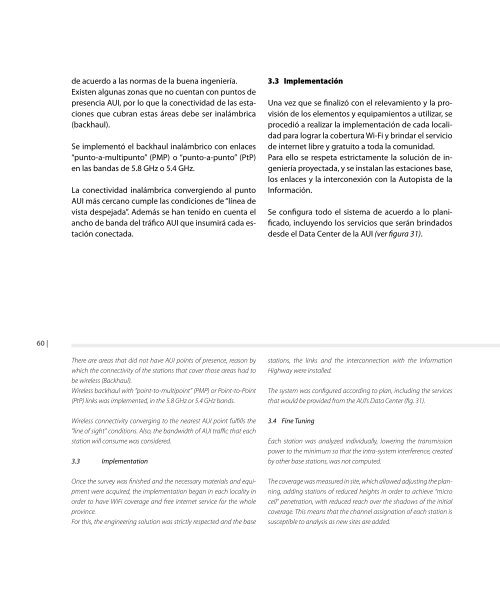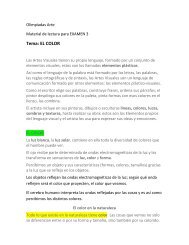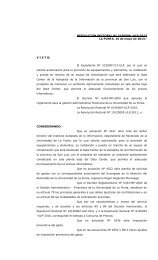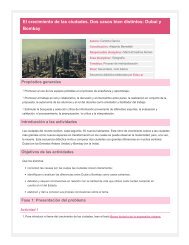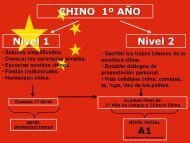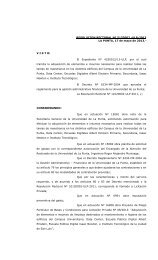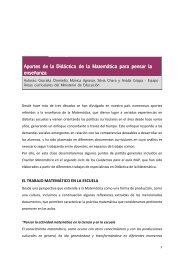e-Book PDF - Universidad de La Punta (ULP)
e-Book PDF - Universidad de La Punta (ULP)
e-Book PDF - Universidad de La Punta (ULP)
You also want an ePaper? Increase the reach of your titles
YUMPU automatically turns print PDFs into web optimized ePapers that Google loves.
<strong>de</strong> acuerdo a las normas <strong>de</strong> la buena ingeniería.<br />
Existen algunas zonas que no cuentan con puntos <strong>de</strong><br />
presencia AUI, por lo que la conectividad <strong>de</strong> las estaciones<br />
que cubran estas áreas <strong>de</strong>be ser inalámbrica<br />
(backhaul).<br />
Se implementó el backhaul inalámbrico con enlaces<br />
“punto-a-multipunto” (PMP) o “punto-a-punto” (PtP)<br />
en las bandas <strong>de</strong> 5.8 GHz o 5.4 GHz.<br />
<strong>La</strong> conectividad inalámbrica convergiendo al punto<br />
AUI más cercano cumple las condiciones <strong>de</strong> “línea <strong>de</strong><br />
vista <strong>de</strong>spejada”. A<strong>de</strong>más se han tenido en cuenta el<br />
ancho <strong>de</strong> banda <strong>de</strong>l tráfico AUI que insumirá cada estación<br />
conectada.<br />
3.3 Implementación<br />
Una vez que se finalizó con el relevamiento y la provisión<br />
<strong>de</strong> los elementos y equipamientos a utilizar, se<br />
procedió a realizar la implementación <strong>de</strong> cada localidad<br />
para lograr la cobertura Wi-Fi y brindar el servicio<br />
<strong>de</strong> internet libre y gratuito a toda la comunidad.<br />
Para ello se respeta estrictamente la solución <strong>de</strong> ingeniería<br />
proyectada, y se instalan las estaciones base,<br />
los enlaces y la interconexión con la Autopista <strong>de</strong> la<br />
Información.<br />
Se configura todo el sistema <strong>de</strong> acuerdo a lo planificado,<br />
incluyendo los servicios que serán brindados<br />
<strong>de</strong>s<strong>de</strong> el Data Center <strong>de</strong> la AUI (ver figura 31).<br />
60 |<br />
There are areas that did not have AUI points of presence, reason by<br />
which the connectivity of the stations that cover those areas had to<br />
be wireless (Backhaul).<br />
Wireless backhaul with “point-to-multipoint” (PMP) or Point-to-Point<br />
(PtP) links was implemented, in the 5.8 GHz or 5.4 GHz bands.<br />
Wireless connectivity converging to the nearest AUI point fulfills the<br />
“line of sight” conditions. Also, the bandwidth of AUI traffic that each<br />
station will consume was consi<strong>de</strong>red.<br />
3.3 Implementation<br />
Once the survey was finished and the necessary materials and equipment<br />
were acquired, the implementation began in each locality in<br />
or<strong>de</strong>r to have WiFi coverage and free internet service for the whole<br />
province.<br />
For this, the engineering solution was strictly respected and the base<br />
stations, the links and the interconnection with the Information<br />
Highway were installed.<br />
The system was configured according to plan, including the services<br />
that would be provi<strong>de</strong>d from the AUI’s Data Center (fig. 31).<br />
3.4 Fine Tuning<br />
Each station was analyzed individually, lowering the transmission<br />
power to the minimum so that the intra-system interference, created<br />
by other base stations, was not computed.<br />
The coverage was measured in site, which allowed adjusting the planning,<br />
adding stations of reduced heights in or<strong>de</strong>r to achieve “micro<br />
cell” penetration, with reduced reach over the shadows of the initial<br />
coverage. This means that the channel assignation of each station is<br />
susceptible to analysis as new sites are ad<strong>de</strong>d.


